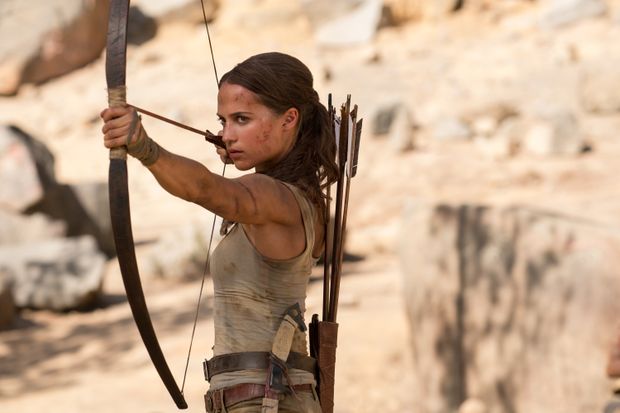While the original Tomb Raider, starring Angelina Jolie and her breasts, has been long criticized and analyzed as a hollow action franchise that fuelled many a pubescent sexual fantasy, its 2018 origin-story remake is a somewhat tedious correction. Alicia Vikander is athletic and spry with a tinier frame than Jolie, and she fits the new character of Lara Croft – a stubborn and impulsive dare-devil – with more charisma than the film deserves. Vikander’s sheer desire to act the hell out of her underwritten role is impressive, in sync with her character’s own relentless drive to find her supposedly dead father, Richard (Dominic West).
Lara’s abandonment issues, outlined through many color-muted flashbacks to Richard leaving the young, crossbow-practising Lara – presumably for his jet-setting business deals – are tidily woven into the plot. When she unlocks an archaeological mystery he left behind just for her (involving the island of Yamatai and the fatal legacy of Queen Himiko), Lara’s hope in his survival is rekindled.
She puts her bike courier days behind her and enlists the services of drunk sailor Lu Ren (Daniel Wu) in Hong Kong to travel to the dangerous island. There, she instead finds Richard’s once-partner, Mathias Vogel (Walton Goggins), a cunning corporate representative. Vogel claims to have killed Richard and only keeps Lara alive to help him unlock the Queen Himiko tomb for his company’s profit.
Barely escaping Vogel’s machine-gun-toting minions and the treacherous waters and terrain of the island, Lara finds her dad, cave-dwelling and mad from Vogel’s avaricious power. Alongside the plucky, tokenized Lu Ren, the three try to stop Vogel opening the tomb which, according to Richard, would unleash a Pandora’s Box and doom the world. The truth is a body-horror scientific discovery that fits the action genre but is pretty boring nonetheless.
Indeed, efforts to carve out a more interesting Lara Croft clearly left screenwriters Alastair Siddons and Geneva Robertson-Dworet little time to write anything more than a derivative archeological adventure story. It’s telling that the opening act – involving a fun bike-chase scene through downtown London, demonstrating Lara’s plucky devil-may-care approach to life – is more interesting than subsequent set pieces, when the stakes are higher.
The emotional underpinnings of the story feel incomplete, to the extent that the film is too busy with death-defying survival scenes and pointed guns to truly reckon with Lara’s abandonment as a child. That her discovery of Richard’s double life as an archaeologist should finally inspire in her a life mission is too easy a narrative setup, and the father-daughter reunion is rushed. Even a dose of humour might have balanced out the emotional stakes and provided a contrast to Vogel’s cartoonish villainy (watch for the risible, melodramatic moment when he points a gun at Lara’s head, Goggins’ eyes nearly popping out before he decides not to shoot her).
Visually, Tomb Raider has few things going for it. Some of the set pieces are so dark it’s hard to know what’s happening, who’s winning, or what CGI dreck we’re supposed to be seeing. The few brief interesting shots – a blue-flashlight lens-flare gleaming through the rib cage of a skeleton is a good one – don’t save the film from the reality that Tomb Raider, with its dusty artifact puzzles and swashbuckling-bravado-enabling-mystery-solving mechanics, clearly works better as a video game than a movie.
The film apes not only Indiana Jones and Uncharted but its own gaming intellectual property: Lara’s terrifying waterfall descent complete with last-second parachute find is taken directly from a 2013 game and seems like it would be more fun with a joystick instead of popcorn in hand.
But if your movie makes people want to play the game instead, that’s a sign of deficient filmmaking – or an extremely overpriced advertisement.
Originally published in The Globe and Mail (March 15, 2018).

